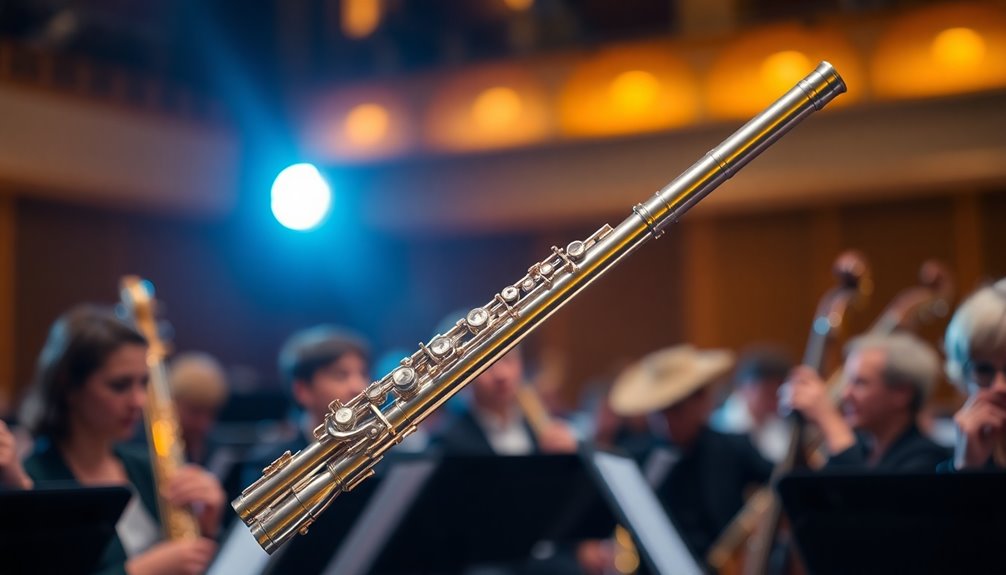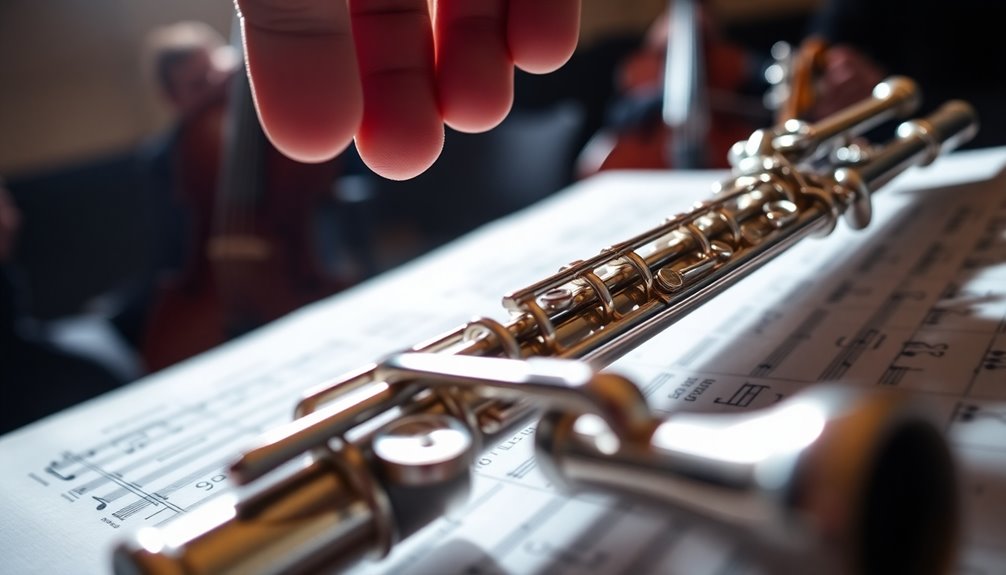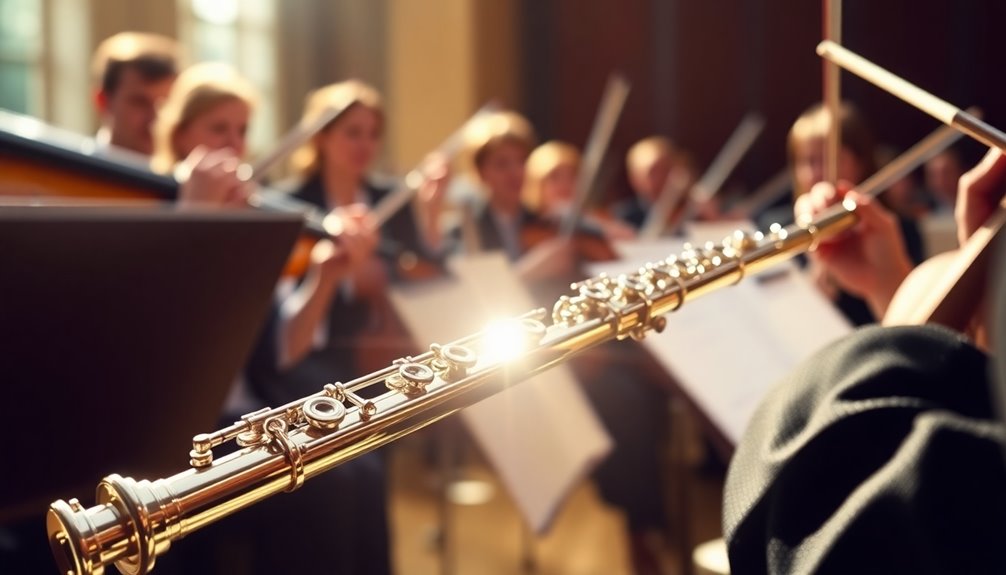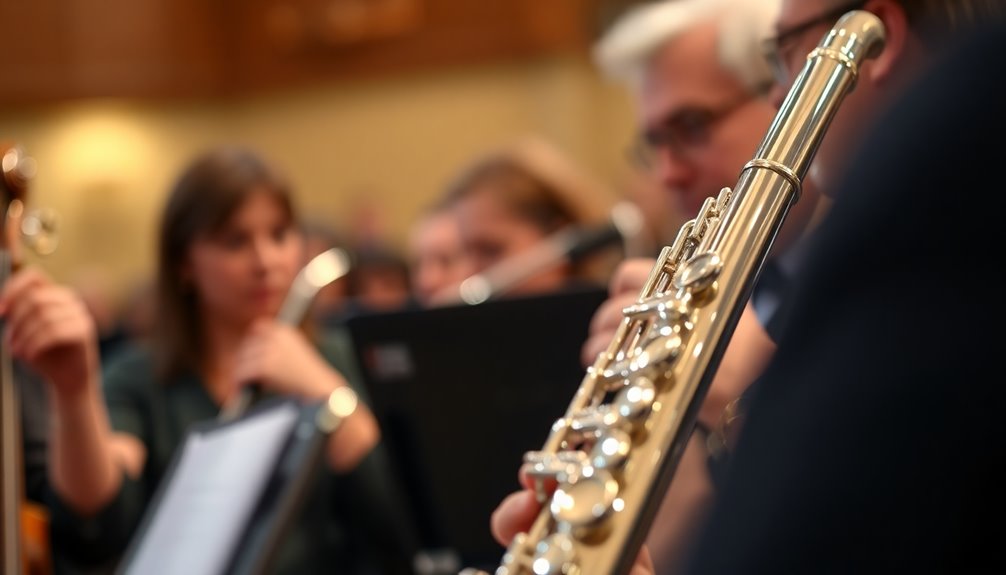The piccolo, often dubbed a high-pitched star, plays an essential role in the orchestra. Its bright, airy sound slices through the woodwind blend, enhancing emotional depth and clarity in orchestral works. Dating back to the Renaissance, this small woodwind instrument gained prominence in the 18th century through composers like Mozart and Beethoven. Its unique tonal qualities allow it to create shimmering effects when paired with strings and provide important accents throughout a composition. To truly appreciate the piccolo's impacts and challenges, you might want to explore its famous passages and the composers who championed its brilliance.
Key Takeaways
- The piccolo's bright, piercing sound cuts through orchestral textures, enhancing emotional expression and musical clarity.
- It serves as a bridge between woodwinds and strings, adding shimmering effects and accents to orchestral pieces.
- Composers like Mozart and Stravinsky prominently feature the piccolo, showcasing its agility and brilliance in their works.
- The instrument's unique tonal quality allows it to produce high-frequency notes, creating depth in the orchestral mix.
- Future innovations and expanded repertoire are ensuring the piccolo's continued relevance and versatility in various musical genres.
The Piccolo: An Overview

When you think of orchestral instruments, the piccolo mightn't be the first that comes to mind, but its impact is unmistakable. This small woodwind instrument, typically made of metal or wood, produces a bright, piercing sound that can cut through the orchestral texture.
There are several piccolo types available, including the concert piccolo and the baroque piccolo, each offering unique tonal qualities and playing techniques. The piccolo plays a significant role in adding brilliance and sparkle to orchestral compositions, often carrying melodic lines that captivate the audience.
Understanding piccolo maintenance is crucial if you want to keep this delicate instrument in prime condition. Regular cleaning and proper handling go a long way in preserving its sound quality.
You should wipe down the exterior after each use and guarantee the pads remain clean and dry. Additionally, periodic professional servicing can help address issues like sticky keys or misaligned pads, ensuring your piccolo performs its best.
Historical Background of the Piccolo

The piccolo has a rich history that stretches back centuries, with roots tracing to the Renaissance and Baroque periods where it was initially used in various forms. Its historical evolution is fascinating, reflecting broader trends in music and instrumentation.
You'll find that the earliest versions, such as the "flauto piccolo," were made of wood and played in ensembles, providing a bright, piercing sound that caught composers' attention.
Key milestones in the piccolo's journey include its standardization in orchestras during the 18th century. Composers like Mozart and Beethoven began incorporating it into their works, showcasing its unique capabilities.
By the 19th century, the piccolo shifted to a metal construction, which increased its volume and projection, further solidifying its role in orchestral settings. Bass flutes have also evolved significantly, becoming recognized for their unique tonal qualities in modern compositions.
As you explore deeper into its history, you'll appreciate how the piccolo not only adapted to changes in musical styles but also became an essential voice in orchestral music.
Its journey mirrors the evolution of music itself, inviting you to connect with its past while anticipating its future in contemporary compositions. Understanding this history enriches your appreciation for the piccolo's vibrant presence today.
The Piccolo's Unique Sound

Within the orchestra, the piccolo stands out for its distinct and penetrating sound, often described as bright and airy. Its high frequency resonance cuts through the ensemble, creating a unique auditory experience that draws listeners in. You can easily identify the piccolo's voice, which carries a bright tonal quality that adds sparkle to orchestral textures.
To illustrate the piccolo's sound characteristics, consider the following table:
| Characteristic | Description | Impact on Music |
|---|---|---|
| High Frequency | Produces notes above middle C | Captures attention in passages |
| Bright Tonal Quality | Clear, vibrant sound | Enhances emotional expression |
| Resonance | Strong presence in orchestral mix | Creates depth and clarity |
The piccolo's ability to soar above other instruments not only showcases its technical prowess but also enriches the overall soundscape. When you listen closely, you'll notice how its bright tonal quality complements other sections, making it an essential component of the orchestra. It's this unique sound that helps the piccolo shine, inviting a sense of belonging among its fellow musicians and audience alike. Additionally, the piccolo's role in orchestras often requires high skill level from its players, emphasizing its importance in achieving the desired musical expression.
Role in the Orchestra

Harmony in the orchestra is enhanced by the piccolo's vital role, acting as a bridge between the woodwinds and strings. Its bright, cutting sound can penetrate the lush textures of orchestral music, allowing it to stand out without overpowering other instruments. This unique position enables the piccolo to contribute to the overall orchestral balance, ensuring that the woodwinds and strings complement each other effectively.
You'll notice how the piccolo dynamics shift throughout a piece, often providing accents and brightening the tonal palette. When paired with strings, it can create a shimmering effect that elevates the music to new heights. In softer passages, the piccolo blends seamlessly, adding subtlety and depth, while in more vigorous sections, it injects energy and excitement.
As you listen to orchestral performances, pay attention to how the piccolo enhances the emotional landscape. Its presence not only adds color but also guides your ear, drawing you into the intricate web of sound. The piccolo's role is further emphasized by its ability to cut through orchestral sound, making it an essential instrument in various musical settings.
Famous Piccolo Passages
Piccolo passages often capture listeners' attention with their brilliance and agility, showcasing the instrument's unique voice in orchestral works. You can find these enchanting moments in several famous compositions, where the piccolo shines brightly.
Here are four notable examples that highlight its charm:
- Mozart's "Concerto for Flute and Harp" – The piccolo adds a sparkling layer that dances above the orchestration, enhancing the playful spirit of the piece.
- Berlioz's "Symphonie Fantastique" – In the "March to the Scaffold," the piccolo's piercing notes create a sense of urgency and drama, perfectly complementing the narrative.
- Stravinsky's "The Firebird" – The piccolo plays an essential role in the "Infernal Dance," where its quick, lively passages drive the excitement of the music.
- Vivaldi's "Piccolo Concerto in C Major" – This work is a staple in piccolo concertos, showcasing the instrument's agility and expressive capabilities.
These examples reflect how the piccolo elevates orchestral music, inviting audiences to experience its enchanting voice and agility. The swab's cleaning efficiency is crucial for maintaining the piccolo's performance quality, ensuring that its brilliance is always on display.
Whether in concert halls or recordings, these passages remind us of the piccolo's special place in the orchestra.
Piccolo Techniques and Challenges

Mastering the piccolo involves a unique set of techniques and challenges that can greatly impact a musician's performance. As you explore the world of piccolo playing, you'll quickly discover that breath control is paramount. The instrument's high pitch demands precise airflow, and even slight inconsistencies can lead to pitch instability.
Developing strong piccolo techniques, like proper embouchure and finger dexterity, is essential to achieving a clean sound and accurate intonation. You'll also face performance challenges that require mental agility. Fast passages, like those found in orchestral pieces, demand not just technical skill but also a deep understanding of musical phrasing.
The piccolo's bright sound can easily become piercing if not carefully managed, so learning to balance dynamics is essential. Furthermore, adapting to different musical styles can be tricky. Whether you're playing Baroque, classical, or contemporary pieces, each genre presents its own set of expectations for articulation and expression.
Incorporating breath awareness exercises into your practice routine can significantly enhance your control and connection to the music. Engaging with a community of fellow piccolo players can provide invaluable support and insights, helping you navigate these challenges and refine your techniques. Embrace the journey; the piccolo's voice is worth the effort!
Composers Who Favor the Piccolo

Throughout music history, various composers have recognized the piccolo's unique qualities and incorporated it into their works to create vivid textures and striking contrasts.
You might be surprised by how many notable works highlight this high-pitched instrument, showcasing the creativity of piccolo composers. Here are four key figures who favored the piccolo:
- Wolfgang Amadeus Mozart: In his opera *The Magic Flute*, the piccolo adds an ethereal quality that enhances the magical atmosphere.
- Igor Stravinsky: In *The Rite of Spring*, the piccolo's piercing sound conveys primal energy and urgency, making it essential to the piece.
- Béla Bartók: His *Concerto for Orchestra* features the piccolo prominently, weaving intricate patterns that enrich the overall texture.
- Paul Hindemith: In works like *Symphonic Metamorphosis*, the piccolo plays a vital role in creating playful contrasts and vibrant colors.
These composers demonstrate how the piccolo can elevate music to extraordinary heights. Additionally, the use of open-hole flutes in orchestras can enhance the overall sound texture, similar to the piccolo's contribution. By embracing the instrument, they've shaped the orchestral landscape, inviting both musicians and audiences to appreciate its brilliance.
You can see how the piccolo truly deserves its star status in the orchestra.
The Piccolo in Different Genres

The piccolo's versatility shines across various musical genres, proving it's not just an orchestral ornament but an essential player in diverse settings.
In jazz, the piccolo adds a unique layer of sound, enhancing the improvisational spirit of the genre. Its bright tones can cut through the ensemble, creating an exciting contrast against the rich textures of brass and woodwinds. You'll often hear piccolos in contemporary jazz pieces, where they contribute playful melodies and spontaneous flourishes, engaging both musicians and listeners alike.
In rock music, the piccolo takes on a bold role, often used to create catchy hooks and memorable riffs. Bands like Jethro Tull have effectively incorporated the piccolo, showcasing its ability to bring a fresh, energetic sound that stands out in a sea of electric guitars and drums. This unexpected choice not only broadens the sonic palette but also invites a deeper connection with the audience, making the music feel more vibrant and dynamic. The piccolo's expressive capabilities also allow it to convey intricate musical narratives, similar to the storytelling found in Broadway performances.
The Future of the Piccolo

As we look towards the future of the piccolo, its role in both traditional and contemporary music continues to evolve. The instrument's adaptability is crucial to its enduring presence, and future innovations promise to enhance its appeal even further.
Here are some exciting developments on the horizon:
- New Materials: Advances in technology might introduce lightweight, durable materials, improving sound quality and playability.
- Expanded Repertoire: Composers are increasingly incorporating the piccolo in diverse genres, allowing for richer, more varied musical experiences.
- Educational Resources: The growth of online platforms will make learning the piccolo more accessible, creating a new generation of players enthusiastic to join the community.
- Collaborative Opportunities: Partnerships with other musicians and ensembles will foster creativity and cross-genre experimentation, pushing the piccolo into uncharted territories.
In this evolving landscape, you'll find that the piccolo isn't just a high-pitched instrument; it's an essential part of a larger narrative in music. Additionally, the increasing popularity of beginner-friendly brands like Yamaha flutes ensures that aspiring piccolo players have access to quality instruments that foster their development.
Embracing these changes, you'll discover a welcoming community that celebrates innovation while honoring tradition. Together, we can guarantee the piccolo remains a cherished voice in the orchestra for years to come.
Frequently Asked Questions
What Materials Are Commonly Used to Make Piccolos?
When you're exploring piccolo construction, you'll find that various material types play a significant role in the instrument's sound and durability.
Most piccolos are crafted from wood, such as grenadilla or rosewood, which offer a warm tone.
Alternatively, many professional models use metal, like silver or nickel, for a brighter, more piercing sound.
Each material influences your playing experience, so consider what resonates with you as you choose your perfect piccolo.
How Do I Care for and Maintain a Piccolo?
To care for and maintain your piccolo, start with regular cleaning. Use a soft cloth to wipe down the exterior after each use, preventing moisture buildup.
For deeper cleaning, consider a cleaning rod and swabs specifically designed for piccolos. Keep the pads dry and avoid extreme temperatures.
Regular maintenance tips include checking for leaks and ensuring proper alignment of keys.
With these practices, you'll enhance your piccolo's longevity and sound quality.
Can Beginners Learn to Play the Piccolo Easily?
Yes, beginners can learn to play the piccolo with dedication and the right approach.
Start by mastering basic fingerings and breath control, which are essential beginner techniques. Incorporate practice tips like setting aside consistent daily practice times and playing along with recordings to develop your ear.
Joining a group or taking lessons can foster a sense of belonging and motivation as you progress.
With patience and perseverance, you'll find joy in making music on the piccolo!
What Are the Common Misconceptions About the Piccolo?
You might think the piccolo's just a squeaky toy, but that's a myth! Many underestimate its versatility, believing it can only play high notes.
In reality, it can blend beautifully across genres, from classical to modern. Some folks even think it's too challenging for beginners, but with practice, anyone can master it.
How Does the Piccolo Compare to the Flute in Terms of Complexity?
When you compare the piccolo to the flute, you'll notice both share similarities in fingerings and techniques, yet the piccolo demands more precision due to its higher pitch.
Mastering piccolo techniques requires careful control of breath and articulation, making it seem complex to some.
However, once you grasp the basics, you'll find a rewarding challenge that enhances your overall musicianship, creating a deeper connection to both instruments and their unique sounds.
Conclusion
In the grand tapestry of orchestral music, the piccolo might seem like a diminutive note, but its voice resonates profoundly. This high-pitched star not only adds sparkle to the ensemble but also weaves intricate melodies that captivate listeners. As composers continue to embrace its vibrant timbre, the piccolo's journey isn't just a fleeting moment; it's an evolving narrative that promises to enrich diverse genres. So, let's celebrate this delightful instrument and its bright future in the world of music.






